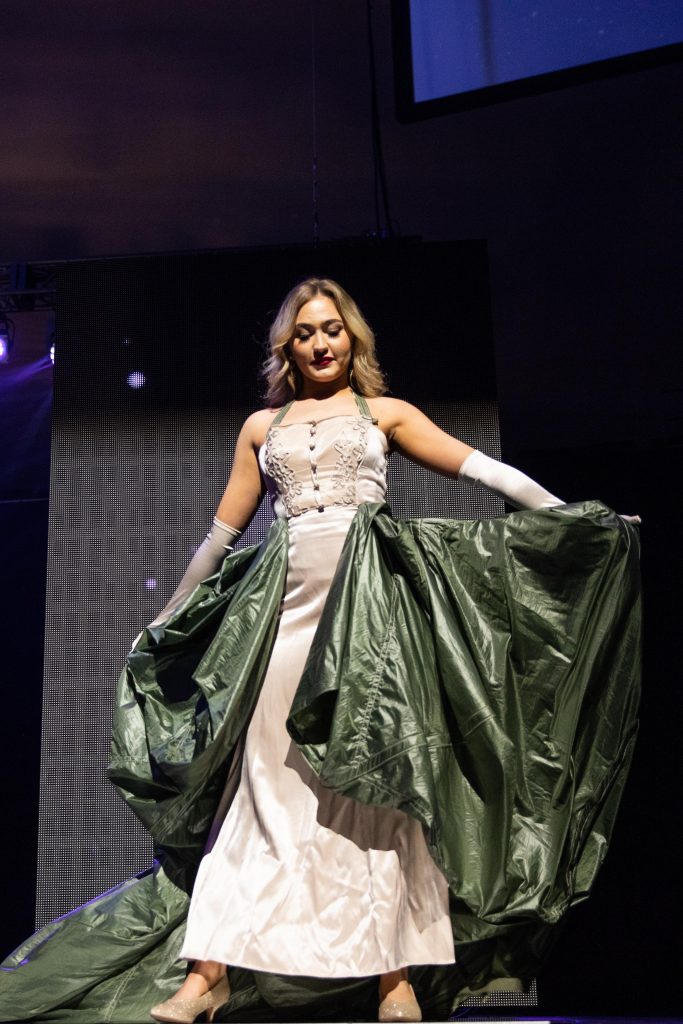From Parachutes To Shower Curtains, Student Designers Upcycle Materials For Fashion

Hours of tedious sewing, meticulous rehearsals and countless emails over the last seven months have been poured into an annual full-scale student led fashion show at Liberty University.
The procession of models showcasing hours of unimaginable creativity resembled something out of a New York Fashion Week. As look after look made its way down the runway in the School of Music Concert Hall, audience members buzzed with excitement guessing what type of material the piece in front of them was made from.
Liberty University’s Family & Consumer Sciences (FACS) department threw its 15th annual FACS Fashion Show on April 17. This year’s show, Fashion Reimagined II, focused on sustainability in an attempt to bring awareness and put a stop to fast fashion. The show aims to shed light on the ethics that often go unnoticed in the fashion industry as a whole.
The designers were challenged to create their designs with 50% of the materials from unconventional sources. Some garments incorporated shower curtains, bobby pins and trash bags to name only a few of the upcycled materials in this year’s show.
Fashion Reimagined is a concept dreamed up by Jessica Suiter, co-director of the show. It was originally planned for last year’s show, but Liberty announced its closure due to the global COVID-19 pandemic a week before the show. While designers were judged and awards were given virtually last year, the physical show was halted.
The team this year chose to resurrect the theme of sustainability once more to allow Co-Director Alyssa Self the opportunity to work alongside Suiter to bring her vision of a sustainable fashion show to life. Designers who were awarded last year but were unable to have their garments physically showcased were given the opportunity to have their looks walked in this year’s show so that a live audience could appreciate the beauty of the pieces.
This year’s intermission included a virtual package that showcased interviews with the designers explaining the complexity of their inspiration and why this theme was particularly important to each of them.
The show is volunteer-based with FACS and other majors participating in this multifaceted production.
Matalie Howard, faculty advisor, has been involved with the FACS department since 1988 and attributes the origins of the show entirely to the suggestions of passionate students 15 years ago who expressed interest in honing their talents in designing, sewing and planning. The show has grown exponentially since its beginnings, starting with seven designers and 15 looks to the show this year, the biggest to date, which has 34 designers and 48 looks.
Howard selected a team of directors to oversee the show, the models and the designers. Her hope was to ensure that each area was fine-tuned and students were able to get a true look into the industry many are interested in pursuing.
“Through all of it, I wanted to make sure that we kept it very much educational because of the fact that these are students learning and every point along the way – yes, we build toward the night of the show — is developing your professionalism and your teamwork capabilities and staying on task,” Howard said.
Self said the team meets with designers and later with models in a series of progress checks throughout the year to evaluate the garments. She said this helps to simulate the rigorous schedule and steady progression necessary to make a show run smoothly.
Brianna Hoover, model coordinator, was a part of the show as a model her freshmen year and as the social media coordinator last year. These experiences gave her expertise when holding the model casting call and curating the poses and specialized walk for the runway.
“It’s kind of been a full circle going from being a model to now actually helping the models out. … I am able to relate to the models and be able to see how they are feeling because I was in their shoes three years ago,” Hoover said.
Models and designers communicated throughout the process to ensure that the designer’s vision was as they imagined it would be.

While the show is not for a class, points towards the designers’ final scores come from progress checks and a final garment inspection with Howard and the panel of four judges. In that phase, the garments are evaluated closely based on quality of construction.
Kendra Hicks, design coordinator, appreciated the audience’s reactions to the display of innovation that she and her team members have seen for months.
“It would truly shock some people to know there are students here doing what these designers are doing because it’s absolutely amazing,” Hicks said.
Self admits there are a lot of emotions regarding her hard work finally being over.
“I have mixed emotions of course. I am so excited for all of the designers’ friends, families, (and) models’ friends and families to see the show. I think they have put so much hard work and effort into everything that they have put on the runway,” Self said.
The night ended with designers lined up on the stage hoping to hear their names called to receive an award. Designers were recognized with awards such as “Sustainability,” “Textile Innovation” and “Best Runway Appeal.” Models Dana Lamolinara and Alexander Tyson were awarded “Best Female Presentation” and “Best Male Presentation” respectively. Third overall runner up was Grace Woudenberg. Second overall runner up was Emma Morgan. First overall runner up was Grant Gruver. Best in show went to Brittany Romano.
Nadia Vires is a Feature Reporter. Follow her on Twitter at @nadiavires.
